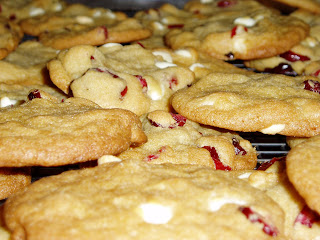
Saturday, December 30, 2006
I inherited The Italian Baker, by Carol Field, from my mother, who got it as one of five cookbooks for $1 in the Book-of-the-Month Club. She could never resist a bargain. She never used the cookbook, and neither have I, although I've looked longingly at the beautiful pictures on the cover from time to time. We must have both thought the recipes would be too complicated or too exotic. But this green peppercorn bread couldn't be easier.
I'd had a bottle of green peppercorns in my pantry for a while, and this seemed like a good opportunity to use them. When I opened them, I suddenly asked myself how long I'd had them. Then I wondered if green peppercorns could spoil. If so, could they kill me? Death by green peppercorns. It seemed unlikely. I decided I could go out and buy a new bottle of green peppercorns, but that seemed wasteful. I went back and forth with myself for a while, but finally decided just to make the bread and not eat it if it didn't taste right.
I adapted the recipe for some of Rose's techniques. I used instant yeast instead of the powdered yeast that needs to be dissolved in water; I did three risings instead of just two; and I used the ice cube method of creating steam.
It looked pretty, as it came out of the oven, and it smelled good, but I was still a little worried about the peppercorns. In fact, I was starting to be obsessed, although that didn't stop me from eating two pieces of bread. I loved the bites with the peppercorns, which tasted just fine, but I still thought I could taste a hint of the brine, which tasted a little formaldehyde-y, in my now somewhat crazed and hypochondriacal opinion.

Two hours later, I checked the computer for symptoms of botulism. Drooping eyelids, difficulty in swallowing and talking, dry mouth. I looked in the mirror. The eyelids seemed OK, and I could swallow, but it might take up to 36 hours for symptoms to show up. There are only 117 cases of botulism reported annually in the United States, most of them in infants. I threw out the rest of the peppercorns, because even if they weren't really bad, they were causing me to behave strangely.
I did another internet search and discovered a site that said green peppercorns packed in brine were almost certain to spoil. Uh-oh. I checked my eyelids again.
I asked Jim if his eyelids seemed all right; he seemed surprised by the question.
I actually would recommend this bread. It's very tasty and easy; I would, however, strongly recommend making it with fresh peppercorns, not some that have been sitting on a pantry shelf for God knows how long.
Pane al Pepe Verde (Green Peppercorn Bread)
2 3/4 - 3 cups (375 grams) unbleached all-purpose flour
3/4 t. instant yeast
1 t. (5 grams) salt
1 1/4 - 1 1/2 T. green peppercorns, rinsed and drained
2 t. olive oil
1 c. water
Whisk flour, yeast, and salt in mixing bowl. Using dough hook, put mixer on low speed and add olive oil and water. When dough starts to come together, increase mixer speed to medium and mix about 4 minutes, until dough is creamy and smooth. Add peppercorns which have been slightly chopped.
Knead dough by hand on floured counter briefly, and put in covered container.
When dough has doubled, about two hours, put on floured counter. Stretch it to a rectangle and make two business-letter folds. Return to container and let double again, about one hour.
Shape into either round or torpedo-shaped loaf and place on baking sheet with parchment. Cover with dish towl or oiled plastic wrap, and let rise another hour.
Preheat oven to 500, put baking stone on lowest rack. Put another baking sheet or a cast iron pan on the bottom of the oven.
When dough has risen, make several slashes and put in oven. Add 1/2 cup of ice cubes to baking sheet or cast iron pan.
Immediately lower heat to 400. Bake about 35 minutes. Halfway through baking, put loaf directly on baking stone.
(Adapted from The Italian Baker)


































 alt="" />
alt="" />











